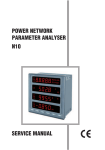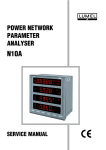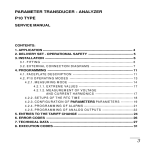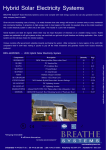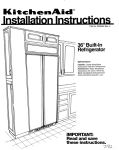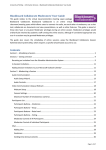Download power network parameter analyser n10 service manual
Transcript
POWER NETWORK PARAMETER ANALYSER N10 SERVICE MANUAL POWER NETWORK PARAMETER ANALYSER N10 Service manual 1. APPLICATION..........................................................................5 2. METER SET.............................................................................5 3. INSTALLATION........................................................................6 3.1. FITTING................................................................................6 3.2. EXTERNAL CONNECTION DIAGRAMS.......................................7 4. PROGRAMMING...................................................................12 4.1. FACEPLATE DESCRIPTION...................................................12 4.2. N10 OPERATING MODES......................................................14 4.2.1 MEASURING MODE............................................................15 4.2.1.1. Measurement of voltage and current harmonics.......................16 4.2.2. TIME SETTING MODE - t.....................................................17 4.2.3. PARAMETER CONFIGURATION MODE - S.............................18 4.2.4. ALARM CONFIGURATION MODE - A.....................................20 4.2.5. PAGE CONFIGURATION MODE - P ......................................22 5. ERROR CODES.....................................................................25 6. TECHNICAL DATA................................................................27 7. ORDERING CODES..............................................................30 8. MAINTENANCE AND GUARANTEE....................................31 March 2007 - KZ 1268/06 1. APPLICATION The N10 type meter is a programmable digital instrument destined to measure parameters in three-phase, 3 or 4-wire power networks, in symmetric and asymmetric systems with the simultaneous display of measured quantities and the digital transmission of their values and their conversion into an analog standard signal. This meter enables the control and optimization of power electronic devices, systems and industrial installations. It ensures the measurement of: RMS voltage and current, active power and energy, reactive power and energy, power factors, frequency, 15-minutes active mean powers. Voltages and currents are multiplied by given voltage and current ratios of voltage and current measuring transformers. Power and energy indications take into consideration values of programmed ratios. This meter indicates additionally the actual time. The value of each measured quantity can be transmitted to the superordinated system through the RS-485 interface. One of the chosen quantity can be additionally transmitted by means of a standard current signal, three relays outputs can be used to signalize exceedings of chosen quantities, a pulse output to control energy counters with pulse inputs, and a pulse input to check counters having pulse outputs. Measurements are carried out by the sampling method of voltage and current signals. The meter is adapted to be fixed into a pannel by means of holders. 2. METER SET The set includes: - N10 type meter - service manual - guarantee card - holders to fix into a pannel 1 pc. 1 pc. 1 pc. 4 pcs. Additionally for the execution with interface: - service manual of the serial interface 1 pc. - service manual of the WIZPAR program 1 pc - lead of the RS-485 interface 1 pc. - matching resistor 1 pc. - diskette for the WIZPAR program 1 pc. 3. INSTALLATION 3.1. Fitting way The meter is adapted to be mounted by means of holders accor. ding fig.1. The meter housing is made of a sell-extinguishing plastics. Housing dimensions are 144 x 144 x 77mm. At the outside of the meter there are screwed terminal strips which enable the connection up to 2.5 mm2 external leads. Fig.1. Overall dimensions and fitting way of the N10 meter. 3.2. External connection diagrams Direct measurement in a 3-phase network Half-intermediate measurement in a 3-phase network Intermediate measurement using 2-current transformers and 2 or 3 voltage transformers in a 3-phase network Fig. 2. Meter connection diagrams in a three-phase network Direct measurement in a 4-phase network Half-intermediate measurement in a 4-wire network Intermediate measurement using 2-current transformers and 2 or 3 voltage transformers in a 3-phase network Fig. 3. Meter connection diagrams in a four-wire network 10 Fig. 4. Connecting way of N10 meters with an RS-485 interface. 11 NOTICE: To make the IBM PC - N10 meter (RS-485) connection it is recommended to use a double-wire twisted conductor in a screen. The screen should be connected to the earth in one point. The screening is necessary when the environment is very perturbed. 4. PROGRAMMING 4.1. Faceplate description Fig. 5. View of the N10 meter faceplate The N10 meter has 6 keys, four 5-digits display sections and illuminated symbols and parameter units. Values of measured. parameters are shown on active pages selected by successive. pressures of the key. A page consists of 4 optional quantities chosen from the table 5 and displayed simultaneously on the meter. The page definition is described in the configuration mode P. 12 Table 1 1 ENTER acceptance key 2 Right displacement key 3 Value increase key 4 Value decrease key 5 Left displacement key 6 ESC resignation key The assignment of individual keys is as follows: Key It is destined to accept the introduced value during the programmation. It enables the change of pages in the measuring mode. Keys They are destined to change the digit value on the decimal position during the programmation. They enable the display of suitably minimal and maximal values. Keys They allow the cursor displacement to successive decimal positions during the programmation and enable the change of display luminosity. Key This key enables in anytime the resignation of carried out operations. It cancels alarms in measuring mode. 13 4.2. N10 operating modes The N10 meter has 5 operating modes represented . on the table 2. Table 2 MODE NAME CALLING OUT SYMBOL Understood Measuring OUTPUT INPUT Time setting t in SETUP procedure Page . configuration P in SETUP procedure Parameter . configuration S in SETUP procedure Alarm . configuration A in SETUP procedure Through input to . another mode or after the last parameter or after the last parameter or after the last parameter or after the last parameter After its switching on, the meter makes tests informing by the . announcement: where: h2.02 - No of the actual program version, After tests carrying out, the meter enters into the measuring mode and displays the page positioned before switching off. The entry into another mode is made in the SETUP procedure. In order to enter in the SETUP procedure one should press two keys: during ca 3 seconds, until the audible signal will be switched off. 14 Choose by means of keys the appropriate mode. The active mode t, P, S or A is signalled by the flashing of the suitable symbol. Accept the chosen mode by the key. The return from other modes into the measuring mode is carried out by means of the or key: - after the last parameter (in t, S and A modes), - after the last page (in the P mode). 4.2.1. Measuring mode Values of different quantities are displayed acc. programmed pages by the manufacturer or configurated by the user in the P mode. Key. The The change of page is realized by pressing the sequence of displayed pages is proceeded acc. the table formed in the P mode. The monitoring of maximal or minimal values is realized when pressing respectively the or key. The cancellation of maximal or minimal values is realized when pressing the key during or key the monitoring of these values, i.e. at first the must be pressed and after the key. Alarms are active if they were allocated. One must notice that alarm do not need to be related to quantities displayed on the page, because a change of page would cause an action on two-state outputs. 15 4.2.1.1. Measurement of voltages and current harmonics The selection of harmonics is made by pressing for reviewing current harmonic, or by ing voltage harmonics. keys keys for review- The selected U1,U2,U3 or I1,I2, I3 quantity is signalled by the flashing of the suitable digit. One must choose by the or key the required quantity and press the key. The following quantities will be displayed: Where: w-n - chosen quantity, e.g. U-1 n-n - harmonic number xxx.x - value of the n-th harmonic The harmonic number up to the 25th harmonic can be changed by means of or keys. The active position is signalled by the cursor. One can return to display the selection of reviewed harmonics by pressing the key. A successive pressure of the key means the return to the measuring mode. For wrong THD indications, successive harmonic values will not be displayed. 16 NOTICE: Indications appear when the parameter 22 will be switch on in the SETUP mode, i.e. the selection of the harmonic measurement and the assumptions concerning the measurement will be fulfilled. 4.2.2. Setting time mode - t After the entry into the SETUP procedure one must choose the mode t by pressing the or key and the key. Following values will be displayed: Where: yyyy - year mm - month dd - day By means of keys required values can be set, i.e. the position of the decimal digit can be choosen by the or key, the digit value by the or key. The cursor signalizes the active position. The set value can be accepted by the key or cancelled by the key and comes back into the measuring mode. causes the arrangement on the successive parameter. after dd (day), causes the transition to hours and minutes settings. Where: hh - hours mm - minutes ss - secondes 17 The setting of hours and minutes is similar to the setting of the year, month and day. after min (minutes), causes the memorization of set values and the exit from the mode t. The seconde counter is not be set but it is zeroed when accepting minutes. This means that in order to obtain an accurate timer setting one must wait till a full minute and then press the key (ENTER). 4.2.3. Parameter configuration mode - S This mode is destined to set meter parameters, input and output signal values. The entry into the parameter configuration mode is protected by the access code if an access code different from zero had been introduced. In the case of 0000 code, password inquiry is omitted. If the access code is different from zero, there is the possibility of parameter reviewing, but changes are locked. Values are set in this mode acc. the table 3. Table 3 Item Parameter name 1 Introduction of access code 2 Setting of meter parameters by the manufacturer Ratio of current transformer Ratio of voltage transformer 3 4 5 6 7 18 Designa tion SECU Range 0000...9999 0000 -without code rESt Y/n tr_I 1...20000 tr_U 1...4000 Quantity on the continuous output Factor of output rescaling Ao_n Range of the continuous output Ao_0 Notice/description Manufacturer’s values 0000 n 1 1 Quantity code acc. table 5 1 Ao_L 80...120% 100 0,4 0 - 0...20mA. 4 - 4...20mA 4 0...34 Table 3 Quantity code acc. table 5 Pulse number/. 1kWh,kVar,kVAhmax 2 pulses/sec. Quantity code acc. table 5 1000 Pulse number/ 1kWh,kVarh,kVAh 1000 PI_0 Y/n n EnP0 Y/n n Enq0 Y/n n EnS0 Y/n n PA_0 Y/n n 8 Quantity on the pulse output Po_n 0, 35...37 9 Constans of the pulse output Po_c 0...9999 10 Quantity on the pulse input Constant of the external energy counter (pulse input) Cancellation of the external energy counter (counter of the pulse input) Cancellation of the active energy counter Cancellation of the reactive energy counter Cancellation of the apparent energy counter PI_n 0, 38...40 PI_c 1...9999 11 12 13 14 15 16 17 18 19 20 21 22 23 Cancellation of the . 15-minutes active power PAV (max. and min. Value) Averaging time of PAV power Synchronization of the PAV power averaging to the real timer Meter address in the system Rate of the serial interface Interface working modetr Selection of the harmonic measurement Change of the access code PA_t 15, 30, 60 min. PA_S Adr bAUd trYb Har 35 38 15 Y/n 1...247 300,600,..,. 19200 0 -switched off interface 0, 1, ...,6 1 -MODBUS ASCII 8N1 2 -MODBUS ASCII 7E1 3 -MODBUS ASCII 7O1 4 -MODBUS RTU 8N2 5 -MODBUS RTU 8E1 6 -MODBUS RTU 8O1 n 1 9600 0 0.1 0 0000...9999 0000 In parameters 5, 8, 10, 21 the range 0 means that the appropriate output, input is switched off. 19 Notations: N - lack of parity (no parity), E - bit checking the even parity, O - bit checking the odd parity. The entry into the procedure causes the setting on the parameter 1 or 2 if the access code is equal 0000. We adjust required values by means of keys, i.e. one can choose the position of the decimal digit by pressing the or key, the digit value by pressing the or key. The active position is signalled by the cursor. One can accept the established value by pressing the key or cancel it by pressing the key and come back to the measuring mode. causes the setting on the successive parameter. after the last parameter, causes the memorization of setting values and the exit from the mode S. Notice: PA_S=Y means that the average power PAV will be brought up to date every 15, 30, or 60 minutes synchronized with the internal virtual timer. PA_S=n means that the average power will be calculated for the last 15, 30, or 60 minutes and brought up to date every 1 seconde, so-called „moving window”. 4.2.4. Alarm configuration mode - A This mode serves to: - attribute the quantity to alarms, - Set the thresholds setting of alarm switching on and off . (also the direction of alarm action). 20 Table 4 Item Parameter name 1 2 3 4 5 6 7 8 9 10 Two state output 1quantity Two state output 1switch on value Two state output 1switch off value Two state output 2quantity Two state output 2switch on value Two state output 2switch off value Two state output 3quantity Two state output 3switch on value Two state output 3switch off value Delay of alarm action Designa tion Range Notice/description Manufacturer’s values A1_n 0, 1...34 Quantity code acc. table 5 2 A1on 0...120 [%] A1oF 0...120 [%] A2_n 0, 1...34 A2on 0...120 [%] A2oF 0...120 [%] A3_n 0, 1...34 A3on 0...120 [%] A3oF 0...120 [%] ALdt 0...100 sec 101 99 Quantity code acc. table 5 9 101 99 Quantity code acc. table 5 16 101 99 Time lag of alarm switching on 0 The entry into the mode of alarm setting is not protected by the access code. Alarms are active if they were attributed, i.e. if a measured quantity different than zero (table 5) has been attributed to them. One must notice that alarms concern chosen quantities in the basic configuration mode S and they are not related with quantities displayed on the page. If the quantity value related to the alarm exceeds the declared threshold, the two-state output corresponding to this alarm will be switched on (relay) and the symbol Ai will be lighted. If the quantity value decreases below the alarm threshold, the two-state output is switched off, but the Ai signalling remains until the time of its cancellation by means of the ESC key. The Aion < AioF setting causes the alarm inverse action, i.e. the output is switched on if the prescribed value decreases below the Aion value and the output is switched off if the value increases above the AioF threshold. 21 4.2.5. Page configuration mode - P This mode is used to select quantities displayed simultaneously on the meter, i.e. to define user’s pages. A list of possible quantities and their codes are inserted in the table 5. Table 5. Code 00 Quantity name Unit Symbol Signalling Without quantity - display extinguished Mark . 01 Phase 1 voltage U1 (k)V L1 02 Line L1 current I1 (k)A L1 03 Phase L1 active power P1 (M,k)W L1 /- 04 Phase L1 reactive power Q1 (M,k)VAr L1 /- 05 Phase L1 apparent power S1 (M,k)VA L1 06 Phase L1 active power factor (Pf1= P1/ S1) Pf1 Pf L1 . /- 07 Phase L1 t1 factor (t1= Q1/ P1) t1 t L1 /- 08 Phase L2 voltage U2 (k)V L2 L2 09 Line L2 current I2 (k)A 10 Phase L2 active power P2 (M,k)W L2 /- 11 Phase L2 reactive power Q2 (M,k)VAr L2 /- 12 Phase L2 apparent power S2 (M,k)VA L2 13 Phase L2 active power factor (Pf2= P2/ S2) Pf2 Pf L2 . /- 14 Phase L2 t2 factor (t2= Q2/ P2) t2 t L2 /- 15 Phase 3 voltage U3 (k)V L3 L3 16 Line L3 current I3 (k)A 17 Phase L3 active power P3 (M,k)W L3 /- 18 Phase L3 reactive power Q3 (M,k)VAr L3 /- 19 Phase L3 apparent power S3 (M,k)VA L3 20 Phase L3 active power factor (Pf3= P3/ S3) Pf3 Pf L3 . //- 21 Phase L3 t3 factor (t3= Q3/ P3) t3 t L3 22 Average 3-phase voltage Us (k)V 1,2,3 23 Average 3-phase current Is (k)A L1,L2,L3 22 24 3-phase active power P (M,k)W L1,L2,L3 /- 25 3-phase reactive power Q (M,k)VAr L1,L2,L3 /- 26 3-phase apparent power S (M,k)VA L1,L2,L3 27 Active power factor (Pf= P/ S) Pf Pf L1,L2,L3 /- 28 Average 3-phase t( factor (t= Q/P) t t L1,L2,L3 . /- 29 Frequency f Hz 30 Voltage between lines L1-L2 U12 (k)V L1,L2 31 Voltage between lines L2-L3 U23 (k)V L2,L3 32 Voltage between lines L3-L1 U31 (k)V L3,L1 33 Average between lines voiltage U123 (k)V L1,L2,L3 34 15-minutes average active power PAV (M,k)W 1, 2, 3 35 3-phase active energy EnP (M,k)Wh L1,L2,L3 /- 36 3-phase reactive energy Enb (M,k)VArh L1,L2,L3 /- 37 3-phase apparent energy EnS (M,k)VAh L1,L2,L3 38 Active energy from external counter EnPz (M,k)Wh . 39 Reactive energy from external counter Enbz (M,k)VArh . 40 Apparent energy from external counter EnSz (M,k)VA . 41 Date - day, month 42 Date - year 43 Time - hours, minutes 44 Time - secondes 45 THD of the phase L1 voltage THD U1 V% L1 46 THD of the phase L2 voltage THD U2 V% L2 47 THD of the phase L3 voltage THD U3 V% L3 48 THD of the phase L1 current THD I1 A% L1 49 THD of the phase L2 current THD I2 A% L2 50 THD of the phase L3 current THD I3 A% L3 In the case of parameters 40...50, the denominations V and A have got a conventional character distinguishing the given parameter, the basic quantity in %. 23 In order to define pages one must enter into the mode P. keys set the number nn By pressing of user’s pages from the range 00...20. Accept by the key the chosen mode. If the number of pages is set 00, it means that the user did not decide to define own pages and chose 7 pages programmed by the manufacturer. Manufacturer’s settings are shown below: Page 1 Page 2 Page 3 Page 4 30 31 32 33 01 08 15 22 U1(k)V U2(k)V U3(k)V Us(k)V 24 25 26 27 Page 5 P (Mk) W Q (Mk) VAr S (Mk) VA Pf U12(k)V U23(k)V U31(k)V U123(k)V 35 36 37 38 02 09 16 23 I1(k)A I2(k)A I3(k)A Is (k)A Page 6 EnP (Mk) Wh EnB (Mk) VArh EnS (Mk) VAh f 03 10 17 24 41 42 43 44 P1 (Mk)W P2 (Mk)W P3 (Mk)W P (Mk)W Page 7 dd.mm yyyy hh.mm ss If a non-zero number of pages has been set then one must define the page contents. nn - page number kk - quantity code acc. . to the table 5. 24 By pressing keys, set required quantities on successive display sections. The active position is signaled by the cursor. One can accept the established value by the key or cancel it by pressing the key. causes the setting on the next parameter or the . successive page. after the last page, causes the memorization of pages . and the exit from the configuration mode P. 5. ERROR CODES During the meter operation, communicates concerning errors can occur. Causes of errors are presented below: Err1 -when the voltage or the current is too low during the . measurement: Pfi ,ti below 7% Un and (or) below 2% In f below 0,5% THD Ui, THD Ii, below 1% Un,In - or the full interval of the PA_t averaging time is not . elapsed yet, Err2-Lack of possibility to define the maximal or minimal . quantity value (lack of current, usually after the meter . switching on or the cancellation of extremal values) Lo F - frequency lower than 47 Hz for THD Ui, THD Ii . measurements, Hi F - frequency higher than 52 Hz for THD Ui, THD Ii . measurements. 25 Fig.6 N10 meter working modes. 26 6. TECHNICAL DATA Measuring ranges and admissible basic errors are shown on the table 6 Table 6 Measured quantity Range 100.0 V (Ku=1) 400.0 V (Ku=1) for Ku1... 400.0 kV Basic error remarks U i voltage (0.2% m.v. +0.1% range) Ku = 1...4000 I i current 1.000 A (Ki=1) 5.000 A (Ki=1) for Ki1... 20.00 kA (0.2% m.v. +0.1% range) Ki = 1... 20000 0.0... (-)1999.9 W (Wh) for Ku1, Ki1 ...(-)1999.9 MW (MWh) (0.5% m.v. +0.2% range) 0.0... 1999.9 VA (VAh) for Ku1, Ki1 ...1999.9 MVA (MVAh) (0.5% m.v. +0.2% range) 0.0... (-)1999.9 Var (Varh) for Ku1, Ki1 (-)1999.9 MVar (MVarh) (0.5% m.v. +0.2% range) - 1.00 ...0.00 ...1.000 1% m.v. 2c Pf=Power factor=P/S tg i factor (ratio of reactive power to active power) - 99.9....0....99.9 1% m.v. 2c Error in the range: - 99.9...0...99.9 f frequency 15.0... 500.0 Hz 0.5% m.v. 0.2... 200% 0.5% m.v. 2c P i active power PAV mean active power Active energy EnP, EnPz S i apparent power. Apparent energy EnS, EnSz Q i reactive power. Reactive energy EnQz Pf i active power factor THD U, THD I harmonics Error in the range: 10...120% U, I 47... 52 Hz Where: Ku - voltage transformer ratio Ki - current transformer ratio m.v. - measured value c - less significant display digit THD U - full distorsion factor (by voltage harmonics) THD I - full distorsion factor (by current harmonics) 27 Power consumption: - supply circuit - voltage circuit - current circuit 12 VA 0.5 VA 0.1 VA Supply voltage 85...250 V d.c. or a.c., 40...400 Hz Display section 4 x 5 LED digits, 14 mm high red . or green digits Analog output 0...20 mA, (4...20 mA) selected . from the keyboard, accuracy 0.5% Relay output 3 relays, voltageless make . contacts, . Load capacity 250 V a.c./ 0.5 A~ Passive pulse output 0...2 Hz 12...50 V d.c. (5...20 mA) Passive pulse input 0/24 V d.c. 50%, Measurement of the harmonics (Up to the 25 th) for currents and voltages THD - Total Harmonic Distortion for currents and voltages Serial interface RS-485 Transmission protocol MODBUS Meter reaction to decays and supply recovery: data and meter state preservation . during supply decays, (battery . support), work continuation after supply . recovery Degree of protection ensured by the case acc. IEC529: - frontal side - rear side IP 40 IP 10 Weight 0.8 kg Overall dimensions 144 144 77 mm Panel cut-out dimensions 138+0.5 138+0.5 28 Reference conditions and nominal operation conditions: - Input signal: 0...0.01...1.2 In; 0...0.01...1.2 Un, for voltage, current, . frequency, power and energy 0...0.02...1.2 In; 0...0.07...1.2 Un, for Pf and t factors, . frequency 15...45...65...500 Hz . sinusoidal input signal THD 8% 0.1...1.2 In; 0.1...1.2 Un; 47... 52 Hz, for THDU, THDI and . harmonics - power factor - ambient temperature - air humidity - power supply - admissible peak factor: - current - voltage - external magnetic field - short duration overload (5 sec): - voltage inputs - current inputs - working position - warm-up time - 1...0...1 0...23...55°C 25...95% (no condensation) 85... 253 V d.c. or a.c. 40... 400 Hz 2 2 0...40...400 A/m 2 Un (max.1000 V) 10 In optional 5 minutes Additional errors in % of the basic error: - input signal frequency < 50% - ambient temperature changes < 50%/10C Resistance against supply decays acc. to EN 61000-6-2 Standards fulfilled by the meter: Electromagnetic compatibility: - immunity - emission acc. EN 61000-6-2 acc. EN 61000-6-4 Safety requirements: acc. EN 61010-1 - insulation ensured by the housing dual - insulation between circuits basic - installation category III - pollution degree 2 - maximal working voltage in relation to ground 600 V a.c. 29 7. ORDERING CODES Execution codes for the N10 network parameter meter Table 7 NETWORK PARAMETER METER N10 Input current I n: 1 A (X/1) 5 A (X/5) acc. order * Input phase voltage Un: 100 V 400 V acc. order * X X X X X XX X 1 2 9 1 2 9 Digital output: without interface with RS 485 interface Display: red digits green digits Power supply: 85...250 V d.c. or a.c. 40...400 Hz acc. order* 0 1 1 2 0 9 Kind of execution: standard custom-made Acceptance tests: without additional requirements with a quality inspection certificate acc. customer’s agreements ** * after agreement with the manufacturer ** the execution numbering will be made by manufacturer 30 00 99 8 7 X ORDERING EXAMPLE: code N10 2 1 1 2 0 00 1-means: input range: 5 A, 100 V, RS-485 interface, green displays, power supply: 85...250 V d.c./a.c., standard execution, with a quality inspection certificate. 8. MAINTENANCE AND GUARANTEE The N10 meter does not require any periodical maintenance. In case of some incorrect unit operations: 1. In the period of 12 months from the date of purchase: One should take the meter down from the installation and return it to the LUMEL’s Quality Control Dept. If the unit has been used in compliance with the instructions, LUMEL S.A. guarantees to repair it free of charge. 2. After the warranty period: One should turn over the meter to repair in a certified service workshop. The disassembling of the housing causes the cancellation of the granted guarantee. Spare parts are available for the period of ten years from the date of purchase. LUMEL S.A. reserves the right to make changes in design and specifications of any products as engineering advances or necessity requires. 31 SALES PROGRAM MEASUREMENT DIGITAL and BARGRAPH PANEL METERS CONTROL MEASURING TRANSDUCERS RECORDING ANALOG PANEL METERS (DIN INSTRUMENTS) ANALOG and DIGITAL CLAMP-ON METERS INDUSTRIAL and HOUSEHOLD CONTROLLERS CHART AND PAPERLESS RECORDERS POWER CONTROL UNITS and INVERTERS LARGE SIZE NUMERIC and ALPHANUMERIC DISPLAYS AUTOMOTIVE DASHBOARD INDICATORS ACCESSORIES FOR MEASURING INSTRUMENTS MEASURING SYSTEMS (ENERGY, HEAT, CONTROL) CUSTOM-MADE PRODUCTS WE ALSO OFFER OUR SERVICES IN THE PRODUCTION OF: ALUMINIUM ALLOY PRESSURE CASTINGS PRECISION ENGINEERING AND THERMOPLASTICS PARTS PRESSURE CASTING DIES AND OTHER TOOLS QUALITY PROCEDURES: According to ISO 9001 and ISO 14001 international requirements. All our instruments have CE mark . For more information, please write to or phone our Export Department Lubuskie Zak³ady Aparatów Elektrycznych LUMEL S.A. ul. Sulechowska 1 65-022 Zielona Góra - Poland Tel.: (48-68) 329 51 00 (exchange) Fax: (48-68) 329 51 01 e-mail: [email protected] http://www.lumel.com.pl Export Department: Tel.: (48-68) 329 53 02 or 04 Fax: (48-68) 325 40 91 e-mail: [email protected]
































